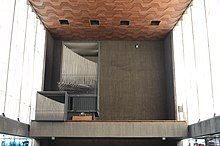Liebfrauenkirche (Duisburg-Mitte)
The Liebfrauenkirche on König-Heinrich-Platz is the former parish church of the Catholic community of Liebfrauen in Duisburg-Mitte. It was consecrated in 1961 and profaned in 2010.
The building has been a listed building since 2005 and has been an independent cultural church since 2013. The sponsor is the non-profit foundation Brennender Dornbusch.
history
Today's Liebfrauenkirche is the successor to the old Liebfrauenkirche, which was almost completely destroyed in 1942 and stood next to the Salvatorkirche . Their remains were incorporated into the new Carmel Church . The Liebfrauengemeinde is the oldest Catholic parish in Duisburg, whose history goes back to the 13th century.
The Liebfrauenkirche was built from 1958 to 1960 in the immediate vicinity of the regional court, the city theater and the Mercator Hall according to a design by the architect Toni Hermanns . Until the end of 2017, the Liebfrauenkirche was a place of eternal adoration .
In the context of the difficult financial situation of the diocese of Essen and the expected numerous church closings, it was possible for the first time in the diocese of Essen to secure this only Duisburg center church through a citizens' initiative by establishing a foundation. The “Burning Bush Foundation” founded in 2007 (based on the unique large portal relief of the church) would like to intensify the “dialogue between religions and cultures”. In addition to religious life, the Liebfrauenkirche will also open up cultural events in the future, with continued services and city pastoral care.
At the end of 2008, the Burning Bush Foundation received an endowment of 1.75 million euros from Duisburg entrepreneur Wilhelm Fasel († October 17, 2009). This capital endowment and the further donation of real estate made it possible to transfer ownership of the listed Church of Our Lady in the center of Duisburg city center to the foundation.
The preservation of the Liebfrauenkirche, which is also financially secured with this endowment, is widely recognized beyond the city limits as an example of exemplary civic engagement. The state government of North Rhine-Westphalia also sees the new foundation as a pilot project, especially against the background of the changed social framework and structural change in the churches.
In 2010 the church was profaned, and a closed room on the ground floor was declared a "sacred space" as a chapel.
In 2011, renovation of the facades began. In order to improve the energy values of the building and to protect the concrete core, the plan was to encase the building with transparent polycarbonate panels as part of the renovation work completed in 2012. The plans were developed at the Technical University of Darmstadt . This innovative method could prove to be a model for the repair of other buildings, especially those from the post-war period.
architecture
The extraordinary and remarkable two-story reinforced concrete building was built in the architectural style of brutalism . The stained glass windows, the canopy and numerous other furnishings in the Church of Our Lady come from the Vatican Church of the Brussels World Exhibition in 1958 . The relief of Moses and the burning bush on the front of the building was created by the sculptor Karl Heinz Türk .
The church building is considered a typical example of the architecture of the late 1950s. Accordingly, the monument authority rates the Liebfrauenkirche as an architecturally and artistically outstanding building.
organ
The organ was built in 1964 by the organ builder Franz Breil (Dorsten). The slider chest instrument has 42 registers on four manuals and a pedal . The Spieltrakturen are mechanically, the Registertrakturen electrically.
|
|
|
|
|
|||||||||||||||||||||||||||||||||||||||||||||||||||||||||||||||||||||||||||||||||||||||||||||||||||||||
- Coupling : II / I, I / P, II / P
See also
Web links
- Kulturkirche Liebfrauen
- Liebfrauenkirche on the website of the city of Duisburg
- Description of this sight on the route of industrial culture
Individual evidence
- ↑ Episcopal General Vicariate Essen, Dept. Information / Episcopal Press Office (ed.): Our common path. 25 years of the Diocese of Essen . Edition Werry, Mülheim an der Ruhr 1982. ISBN 3-88867-019-5 . P. 66.
- ^ Profanation decree . In: Church official gazette diocese of Essen . 53rd year, no. 11 . Essen August 26, 2010, 111 ( bistum-essen.de [PDF; accessed on February 12, 2018]).
- ↑ Liebfrauen with a new dress , Monuments Online 6.2011.
- ↑ under protection certificate
- ↑ Monument protection authority: registration as a monument under the number ZA535
- ↑ More information on the organ (PDF file; 8.1 MB) p. 271
Coordinates: 51 ° 26 ′ 4 " N , 6 ° 46 ′ 11" E





